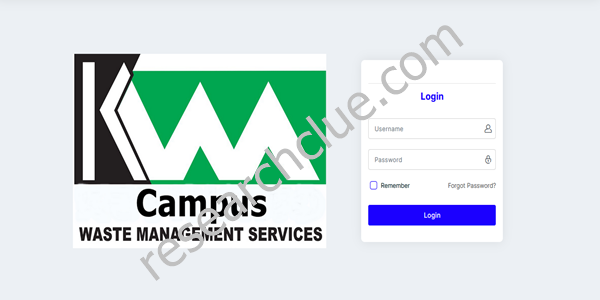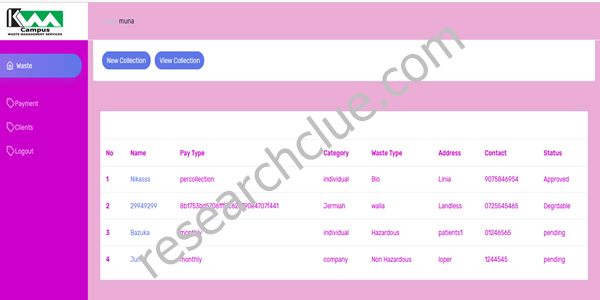CHAPTER ONE
INTRODUCTION
1.1 Background to the Study
In today's global context, sustainable waste management practices have become increasingly critical for preserving environmental integrity and promoting campus sustainability. Higher education institutions, as significant generators of waste, face unique challenges in managing their waste streams efficiently and responsibly. Traditional waste management methods often fall short in effectively addressing the complexities of waste diversion, recycling, and disposal on campus. To tackle these challenges, the design and implementation of an Online Campus Waste Management System (OCWMS) emerge as a pivotal solution. This system leverages digital technologies to streamline waste management processes, enhance data-driven decision-making, and promote sustainable practices across the campus community.
The implementation of an OCWMS offers several advantages over conventional waste management methods. Firstly, it provides a centralized platform accessible to students, faculty, staff, and administrators, facilitating seamless communication and collaboration in waste management efforts (Pereira et al., 2020). Secondly, the digital nature of the system enables real-time monitoring of waste generation, collection, and disposal, allowing for more efficient resource allocation and optimization of waste management practices (Sharma & Shrestha, 2019). Additionally, features such as waste tracking, reporting, and analytics empower stakeholders to make informed decisions and identify opportunities for waste reduction and recycling (Sánchez et al., 2018).
However, despite the evident benefits of implementing an OCWMS, challenges exist in its design and implementation. These challenges may include technological infrastructure requirements, data privacy and security concerns, user adoption and training, and integration with existing campus systems (Biswas et al., 2021). Overcoming these challenges requires a holistic approach that addresses technical, organizational, and behavioral aspects of waste management on campus. By addressing these key issues, the OCWMS aims to promote sustainability, minimize environmental impact, and foster a culture of responsible waste management within the campus community.
1.2 Statement of the Problem
In the context of higher education institutions, the management of campus waste presents significant challenges that require innovative solutions. Traditional waste management methods often lack efficiency, transparency, and sustainability, leading to increased environmental impact and resource depletion. The absence of centralized systems for waste management on campuses exacerbates these challenges, resulting in disjointed efforts, inefficient resource allocation, and suboptimal waste diversion and recycling rates. Furthermore, the lack of real-time data and analytics hinders informed decision-making and prevents institutions from implementing targeted interventions to address specific waste management issues. Thus, there is a pressing need for the design and implementation of an Online Campus Waste Management System (OCWMS) that leverages digital technologies to streamline waste management processes, enhance sustainability practices, and promote a culture of environmental stewardship within the campus community.
The implementation of an OCWMS must address several key challenges to effectively manage campus waste and achieve sustainability goals. These challenges include the development of user-friendly interfaces to ensure widespread adoption and engagement among students, faculty, staff, and administrators. Additionally, integrating the OCWMS with existing campus infrastructure and systems poses technical and logistical hurdles that require careful planning and coordination. Moreover, ensuring data privacy and security within the OCWMS framework is essential to protect sensitive information and maintain trust among stakeholders. Overall, addressing these challenges is crucial for the successful design and implementation of an OCWMS that revolutionizes waste management practices, promotes sustainability, and fosters a culture of environmental responsibility on campus.
1.3 Objectives of the Study
The main objective of the study is to examine Design and Implementation of an online Campus Waste Management System (A case study of University of Uyo). Specific objectives of the study are:
- To design a well-structured and optimized database management system to store, process and retrieve user and waste disposal information in real-time.
- To design and Implement a secure management information system not prone to internal and external attacks.
- To proffer solutions to the challenges and enhance already existing systems in place.
SCREEN SHOTS OF THE APPLICATION


1.4 Significance of the Study
The study is important for many reasons. The following are the major stakeholders this paper through its practical and theoretical implications and findings will be of great significance:
Firstly, the paper will benefit major stakeholders and policy makers in the Information Technology sector. The various analysis, findings and discussions outlined in this paper will serve as a guide in enabling major positive changes in the industry and sub-sectors.
Secondly, the paper is also beneficial to the organizations used for the research. Since first hand data was gotten and analysed from the organization, they stand a chance to benefit directly from the findings of the study in respect to their various organizations. These findings will fast track growth and enable productivity in the organisations used as a case study.
Finally, the paper will serve as a guide to other researchers willing to research further into the subject matter. Through the conclusions, limitations and gaps identified in the subject matter, other student and independent researchers can have a well laid foundation to conduct further studies.
1.7 Scope of the Study
The study is delimited to [case study]. Findings and recommendations from the study reflects the views and opinions of respondents sampled in the area. It may not reflect the entire picture in the population.
1.8 Limitations of the Study
The major limitations of the research study are time, financial constraints and delays from respondents. The researcher had difficulties combining lectures with field work. Financial constraints in form of getting adequate funds and sponsors to print questionnaires, hold Focus group discussions and logistics was recorded. Finally, respondents were a bit reluctant in filling questionnaires and submitting them on time. This delayed the project work a bit.
1.9 Organization of the Study
The study is made up of five (5) Chapters. Chapter one of the study gives a general introduction to the subject matter, background to the problem as well as a detailed problem statement of the research. This chapter also sets the objectives of the paper in motion detailing out the significance and scope of the paper.
Chapter Two of the paper entails the review of related literature with regards to corporate governance and integrated reporting. This chapter outlines the conceptual reviews, theoretical reviews and empirical reviews of the study.
Chapter three focuses on the methodology and analysis of the existing system. This gives an insight into the analysis of systems in place already, facts finding sources, input analysis, output analysis, process analysis and objectives of the new system to be implemented.
Chapter Four focuses on the Analysis of the New system to be Implemented, the design standard, output specification and design, input specification and design, system flow chart and requirements.
Chapter Five outlines the findings, conclusions and recommendations of the study. Based on objectives set out, the researcher concludes the paper by answering all research questions set out in the study.
1.10 Definition of Terms
- Online Campus Waste Management System (OCWMS): A digital platform designed to streamline waste management processes within higher education institutions. The OCWMS facilitates the tracking, monitoring, and optimization of waste collection, disposal, and recycling efforts through online interfaces accessible to students, faculty, staff, and administrators.
- Waste Diversion: The practice of diverting waste materials away from landfills and incinerators towards recycling, composting, or other forms of recovery and reuse. Within the context of an OCWMS, waste diversion refers to the systematic efforts to minimize the amount of waste sent to landfills by promoting recycling, composting, and other sustainable waste management practices.
- Real-time Monitoring: Continuous tracking and surveillance of waste generation, collection, and disposal activities using sensors, data analytics, and online platforms. In the context of an OCWMS, real-time monitoring enables stakeholders to access up-to-date information about waste management processes, identify operational inefficiencies, and implement timely interventions to optimize resource utilization.
- Sustainability Metrics: Quantitative measures used to assess the environmental, social, and economic impacts of waste management practices within higher education institutions. Sustainability metrics within an OCWMS may include metrics such as waste diversion rates, carbon footprint reduction, energy savings, and cost-effectiveness of waste management initiatives.
- Stakeholder Engagement: The active involvement and participation of students, faculty, staff, administrators, and other campus community members in waste management decision-making and implementation processes. Effective stakeholder engagement within an OCWMS fosters collaboration, communication, and shared responsibility for achieving sustainability goals, ultimately enhancing the success and impact of waste management initiatives on campus.
